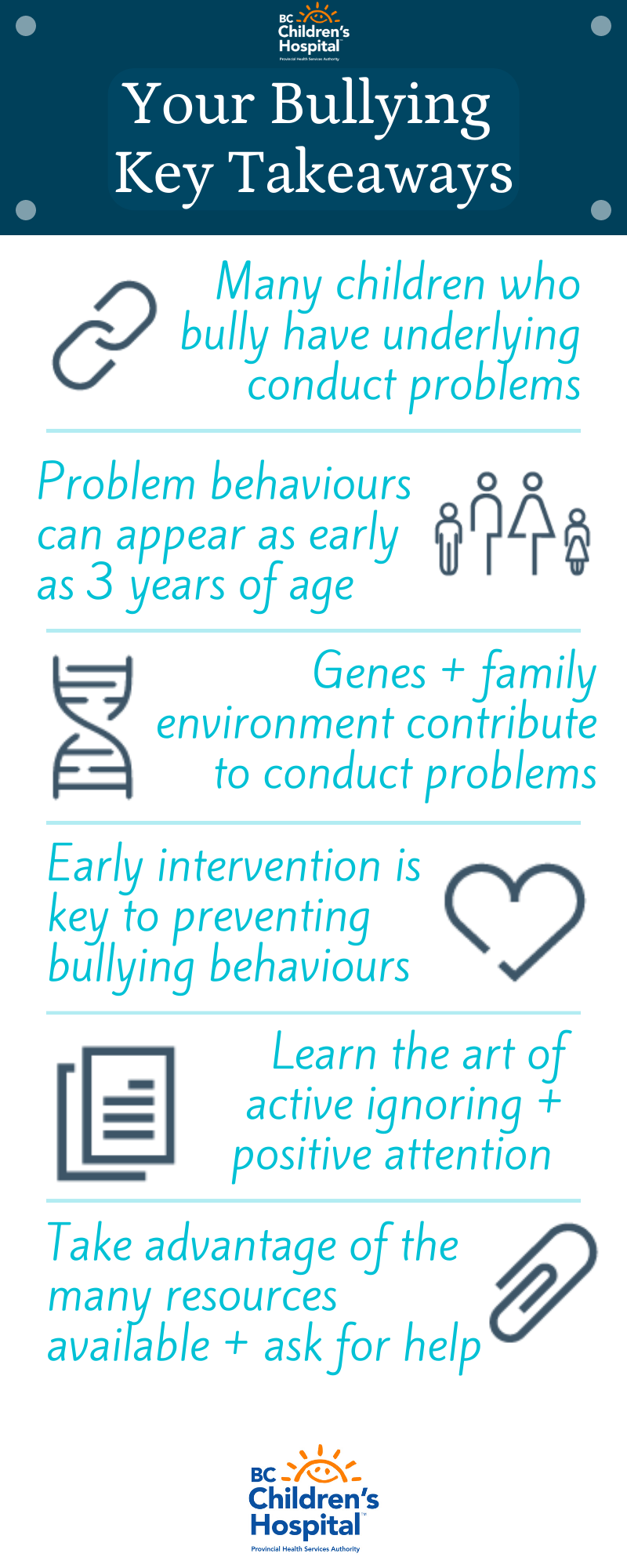BCCHR's Ask an Expert Series

We asked an expert about the underlying factors that lead to bullying and what steps parents can take if their child is bullying others.
Bullying is a significant problem in Canadian schools and can have a lifelong impact on both bullies and their victims. Bullying is often the consequence of underlying serious behavioural problems in children and teens.
Dr. Robert McMahon is a researcher at BC Children’s Hospital and the founder and director of the Institute for the Reduction of Youth Violence at Simon Fraser University.
He’s a co-author of Helping the Noncompliant Child: Family-Based Treatment for Oppositional Behavior, a training text for professionals, and a co-investigator in a 30-year (to date) study of a preventive program called Fast Track, one of the largest trials of its kind to work with youth who are at risk for developing conduct problems.
We caught up with Dr. McMahon to learn more about bullying and how to help kids dealing with underlying behavioural problems.
What types of kids are likely to engage in bullying behaviour?
A child engaged in bullying always has some sort of power over the victim, such as being bigger or stronger or more verbally adept. Boys tend to bully more than girls, but it’s not a big difference. One Canadian survey showed that 18 per cent of boys and 12 per cent of girls had engaged in bullying within the last couple of months. Girls are more likely to engage in verbal and social types of bullying, while boys are more likely to engage in physical types of bullying. Generally, children who bully use aggression to solve problems and many have serious behavioural problems called conduct problems.
What are conduct problems?

Conduct problems are chronic behaviour problems marked by excessive disobedience, aggression, and bullying and/or threatening actions. While some aggression and disobedience is normal in children, what makes this behaviour problematic is when it is ongoing and more severe than is typical. These behaviours can be seen as early as three years of age and they can have a long-term impact on a child’s experiences at school, both socially and academically.
What leads to the development of conduct problems and later bullying behaviour?
While we know that genes can sometimes play a predisposing role, we’ve found that a child’s family environment tends to determine the severity and extent of the behaviours. A lot of times, these kids are exposed to coercion and aggression in the family — in the form of coercive parenting or abuse. They have learned that the use of aggression and coercion is appropriate when dealing with conflict, misunderstanding, or disagreement with others. And they bring this behaviour into their interactions with friends, peers, and teachers.
Why is early intervention so important?
Due to their home environments and ways of interacting with others, these kids’ lives are marked by a lot of interpersonal conflict. By the time they are in high school, they’ve been actively rejected by their peers, they’re often in trouble with their teachers, and they have frequent arguments and fights at home. Teens with conduct problems seem to connect with each other very quickly, often forming what is called deviant peer groups. The individuals in these deviant peer groups teach each other new inappropriate behaviours, such as shoplifting or breaking into cars. There’s a good possibility that they’ve got a juvenile court record and convictions by the end of high school.
Then as young adults, the relationships that they form often tend to be dysfunctional — with a lot of violence and aggression, and they don’t do as well in terms of educational pursuits or careers. In one study, we found that they’re also much more likely to engage in risky sexual behaviour. Our research has shown that early intervention prevents these types of outcomes.
If a parent is worried that their child is bullying others, what should they watch out for?
Watch for things like a child coming home with items that do not belong to them, being physically or verbally aggressive at home, getting into fights at school, getting detention a lot or getting suspended from school, receiving complaints from family members or friends about the child’s aggressive behaviours, and so on. If you notice these signs, seek support from a child psychologist who is trained in treating conduct problems.
What are five things parents can do to avoid the development of conduct problems or bullying behaviour in their children?
- Pay attention to your kids when they are behaving appropriately, and point out the reasons you are pleased with their behaviour. For example, “Thank you for playing nicely with your sister,” “Thanks for staying with me in the store while we’re shopping,” “Thanks for being such a helper by picking out tonight’s dinner.” They eventually learn that the things that Mom or Dad give them positive attention for are the things that they’re going to do more frequently.
- Practice active ignoring when they are engaging in inappropriate, attention-seeking behaviours. If you give them attention (positive or negative) for whining or tantruming, they will tend to do those behaviours more often. Active ignoring should always be used in conjunction with positive attention for appropriate behaviours.
- Avoid aggressive forms of punishment like physical discipline or harsh criticism, since these support the development of conduct problems.
- Give clear instructions, so the child understands what is expected of them. For example, “You need to pick up your toys now.” If they follow through, you can say something like, “Thank you for picking up your toys; I really appreciate it.”
- Learn the art of the timeout. If he or she doesn’t follow through, use a three minute sitting-in-the-chair timeout. Once the child becomes responsive to timeouts, then the parents can set up what we call standing rules. A good example of a standing rule is, “If you ever hit your sister, you’re going directly to timeout.” Things like timeout work because you’re taking something away that the child values, which is attention from Mom or from Dad or access to favourite activities or toys.
What is the number one thing parents need to remember when it comes to conduct problems, bullying and their kids?

If you have concerns about your child’s behaviour, get it looked at as early as possible. A lot of times it’s just normal “terrible twos” or a brief phase in the child’s development, and with some very simple parenting tips things will be fine. But sometimes it’s not and it’s so much easier to address these issues when the kids are preschool age, before they get involved in school and peer networks.
What additional resources would you recommend to parents?
Some of the best work on bullying in Canada has been done by an organization called PREVNet: Promoting Relationships and Eliminating Violence Network. They’ve got portals on their website for parents, teens, school-aged and preschool kids.
In terms of family-based therapies, four of the most well-established programs are:
- Parent-Child Interaction Therapy
- Triple P: Positive Parenting Program
- The Incredible Years
- GenerationPMTO
- In British Columbia, there is an adapted version of GenerationPMTO called Confident Parents: Thriving Kids that is offered by trained counsellors via telephone.
The above sites provide online tools for locating providers and therapists who specialize in family-based interventions and helpful resources, such as blogs and videos to help parents learn more.





